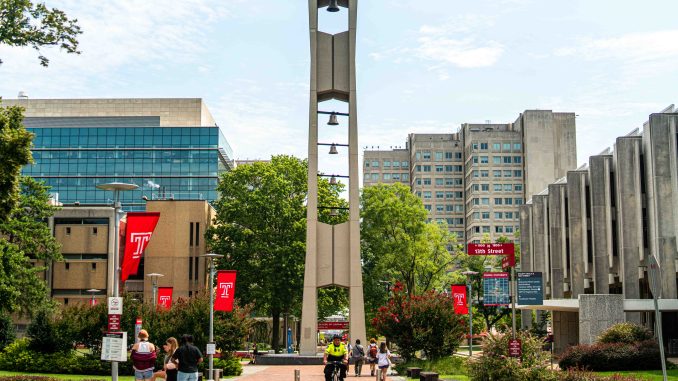
Temple University is in the early stages of gathering input from students to inform the next phase of their campus development plan, Boundless Temple.
The process comes as Provost Gregory Mandel and Senior Vice President and Chief Operating Officer Ken Kaiser announced on April 14 that the phased campus planning approach will identify Temple’s development opportunities and challenges.
Temple is partnering with Sasaki Associates, a design firm that specializes in architecture, planning, landscape and design. The firm will conduct a three-phase effort, which includes listening to the Temple community and its constituents, testing ideas and defining short and long-term plans for implementation.
The new initiative will use direct student feedback, starting with an interactive survey map, where students can mark spots where they study, live or gather. Students can also recommend which spots are “welcoming,” in need of improvement or hard to reach. The survey period will end on May 5.
The survey also allows students to route their paths to and from campus and specify what form of transportation they use to arrive.
“Our online survey, in addition to listening sessions and community outreach, ensures that we collect information from as many people as we can,” wrote David Duxbury, Sasaki’s senior associate planner and project manager for the Temple plan, in a statement to The Temple News. “It represents our commitment and Temple’s that this effort includes as broad a spectrum of input as possible.”
The survey includes separate maps for Main Campus and its patrol zone and the Health Sciences, Center City and Ambler campuses.
Once the survey period ends, the university’s planning steering committee will make short and long-term recommendations based on the data. From there, listening sessions and forums, which are expected to begin in early fall, will also be held for the community to give feedback on the findings, Kaiser said.
Community feedback on master development plans is nothing new for the university, said Kaiser, who is co-chairing the process with Mandel.
“This is the third master plan that I’ve been involved in, going back to 2009 with Temple 20/20 and then Visualize Temple in 2014,” Kaiser said. “Broad community feedback, including students, faculty, staff and the community is critical to the success of any plan. So it’s part of the playbook.”
Typically, universities engage in a comprehensive planning process every 10 years, Kaiser said. Temple’s new plan will also explore enrollment and safety issues and identify opportunities for innovation.
Development plans, like Boundless Temple, include major projects that can sometimes take years, Kaiser said. Charles Library was included in the university’s Temple 20/20 plan from 2009 and the project first broke ground in 2015; the library first opened to the public in September 2019.
Smaller projects, like landscaping and lighting changes, could be seen in the next fiscal year or later in the spring, Kaiser said.
Students are the most fundamental part of the university, so their thoughts are crucial for planning of this magnitude, said former Student Body President Gianni Quattrocchi, who is a member of the university’s steering committee.
“We’re a very ideologically diverse campus so I’m not just providing one side of the argument, so to speak, I’m telling the committee what a wide range of students are thinking and the range of ideas that they have,” Quattrocchi said.
While Quattrocchi acknowledged that the new initiative is a long-term process, he thinks Sasaki’s survey is a very effective way of sourcing student feedback and pinpointing exactly how students view certain spaces on campus.
“It’s going to provide a lot more comprehensive data, and it’s going to be a lot more navigable than a standard sort of multiple choice survey, if you will,” Quattrocchi said. “I think the interactive nature of it is going to provide a lot of useful data that you couldn’t get otherwise.”



Be the first to comment